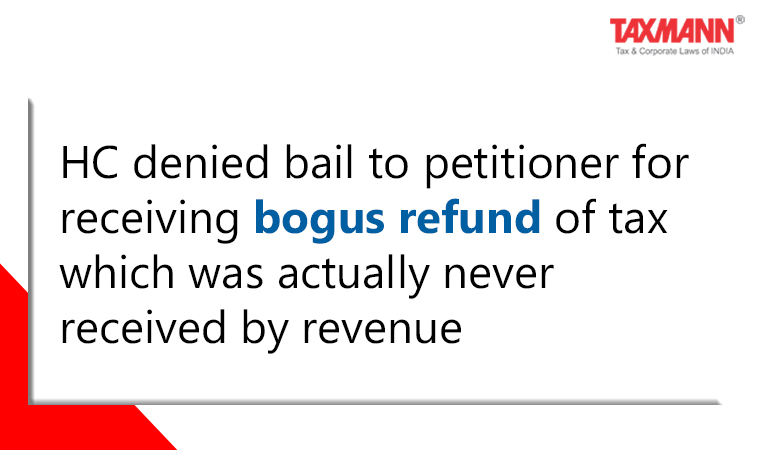HC denied bail to petitioner for receiving bogus refund of tax which was actually never received by revenue
- News|Blog|GST & Customs|
- 2 Min Read
- By Taxmann
- |
- Last Updated on 2 September, 2021
Case details: Rakesh Arora v. State of Punjab - [2021] 129 taxmann.com 286 (Punjab & Haryana)
Judiciary and Counsel Details
-
- Avneesh Jhingan, J.
- Ashok Aggarwal, Sr. Adv. and Priyadarshi Manish, Adv. for the Petitioner.
-
Gaurav Garg Dhuriwala, Sr. Dy. Adv. General and Sourabh Goel, Sr. Panel Counsel for the Respondent.
Facts of the Case
The Goods and Services Tax Department had information that the three firms were engaged in availing and passing bogus Input Tax Credit (ITC). The petitioner was common director in those firms and he was arrested. He submitted that he was in custody since 5th December, 2020 and till date no complaint is filed. He filed application for bail. The department submitted that these firms were procuring bills from Delhi based firms who had no purchases and further billing was done to export units for utilizing the ITC.
High Court Held
The Honorable High Court observed that these firms were procuring bills from firms based at Delhi who had no purchases and tax on which was not deposited to revenue. These firms were not only availing fake ITCs but also getting refunds of ITCs by showing sales to export units. It was also emerged from material collected during investigation that petitioner was one who gave directions to others and such a person if granted bail could flee or abscond. Therefore, it was held that the prayer of petitioner for grant of bail was liable to be rejected.
List of Cases Referred to
-
- Anil Jain v. Directorate of Revenue Intelligence 2007 (207) ELT 215 (Delhi) (para 7)
- Akhil Krishan Maggu v. Dy. Director, Directorate General of GST Intelligence [2019] 111 taxmann.com 367/[2020] 77 GST 279 (Punj. & Har.) (para 8)
- Vimal Yashwantgiri Goswami v. State of Gujarat [2020] 121 taxmann.com 3 (Guj.) (para 9)
- Manoj Cables Ltd. v. Union of India [CWP-8131-2020, dated 16-6-2020) (para 10)
- Tarun Bassi v. State of Punjab [CWP-8004-2020, dated 12-6-2020] (para 10)
- Rajinder Bassi v. State of Punjab [2021] 124 taxmann.com 284 (Punj. & Har.) (para 11)
- Ganga Ram v. State of Punjab [CRM-M-27425-2020, dated 28-20-2020] (para 11)
- R.V. Ramana Reddy v. Union of India [2019] 104 taxmann.com 407/73 GST 727 (Telangana) (para 14)
- State of Gujarat v. Mohanlal Jitamalji Porwal 1987 taxmann.com 612 (SC) (para 34)
- Y.S. Jagan Mohan Reddy v. CBI [2013] 7 SCC 439 (para 35).
Disclaimer: The content/information published on the website is only for general information of the user and shall not be construed as legal advice. While the Taxmann has exercised reasonable efforts to ensure the veracity of information/content published, Taxmann shall be under no liability in any manner whatsoever for incorrect information, if any.

Taxmann Publications has a dedicated in-house Research & Editorial Team. This team consists of a team of Chartered Accountants, Company Secretaries, and Lawyers. This team works under the guidance and supervision of editor-in-chief Mr Rakesh Bhargava.
The Research and Editorial Team is responsible for developing reliable and accurate content for the readers. The team follows the six-sigma approach to achieve the benchmark of zero error in its publications and research platforms. The team ensures that the following publication guidelines are thoroughly followed while developing the content:
- The statutory material is obtained only from the authorized and reliable sources
- All the latest developments in the judicial and legislative fields are covered
- Prepare the analytical write-ups on current, controversial, and important issues to help the readers to understand the concept and its implications
- Every content published by Taxmann is complete, accurate and lucid
- All evidence-based statements are supported with proper reference to Section, Circular No., Notification No. or citations
- The golden rules of grammar, style and consistency are thoroughly followed
- Font and size that’s easy to read and remain consistent across all imprint and digital publications are applied








 CA | CS | CMA
CA | CS | CMA


